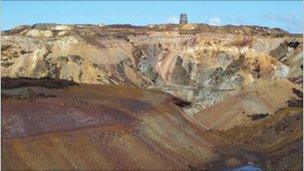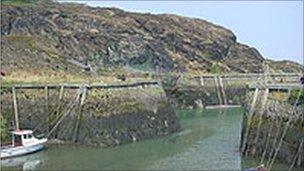Amlwch copper heritage plan wins lottery funding
- Published

Areas of Parys Mountain are sites of special scientific interest because of their geological interest
Plans to celebrate the industrial past of an Anglesey town have received a £700,000 boost.
Lottery funding has been secured to create a heritage centre in Amlwch, marking its copper and shipping history.
The money will also be used to improve the heritage trail around Parys Mountain and 18th Century copper mines.
It is hoped the renovations will be ready by spring 2012.
It is part of a £3m "copper kingdom" tourism project, which will also see buildings like the Cornish Beam Engine House, renovated.
Alison Price, development officer for the Amlwch Industrial Heritage Trust, said volunteers at the site were delighted.
"One of the old copper bins at port Amlwch, previously used to store the metal before it was shipped all over the world, will become a heritage centre," Ms Price explained.
"There will be interpretations on copper mining in Amlwch which goes back to the Bronze Age.
"There will also be information about the mine owners, and the workers, including the famous copper ladies of Amlwch.
"We want it to become a focal point for people to consider the copper kingdom as a tourist destination."
Money will also be spent on updating the sail loft cafe in a building which represent Amlwch's former shipbuilding industry.
The three-hour heritage trail around Parys Mountain will be shortened and made more accessible, and the windmill and pearl engine room will also be saved from further disrepair.

Amlwch was a small hamlet until copper was discovered there in the 18th Century
"When people see Parys Mountain for the first time, they do think they've landed on a different planet," said Ms Price.
"The colours can be spectacular up there.
"But we're not going to 'pretty up' what's left of the opencast mining. We want people to see how it used to be."
Historian Dr John Davies said the world had had its eye on Parys Mountain for thousands of years.
"Places like Parys Mountain and the Great Orme were very interesting to the Greeks, even before Christ," he said.
"They called Britain the tin islands, because they knew of the copper, tin and other minerals here.
"You can almost say Parys Mountain was the beginning of the industrial revolution of the pre-Roman times. It's been vital to the world knowing about Wales."
Dr Davies also thinks Edward I would have been interested in exploiting the copper, as was Elizabeth I.
"Then what happened of course, is the connections with the Vivian family of Swansea [in the 19th Century]," Dr Davies added.

Parys Mountain is filled with tunnels used by miners over the centuries
"They exploited the copper of Parys, mixed it with the tin of Cornwall to create bronze and brass; which is why Swansea was known as the Copperopolis.
"But when the copper was found cheaper in other places, like South America, Swansea turned to them instead."
Ms Price said the trust would work with the community to see how the copper industry affected their ancestors' lives by tracing family histories and gathering aural memories.
Heritage Minister Alun Ffred Jones will visit Amlwch later to learn more about the scheme.